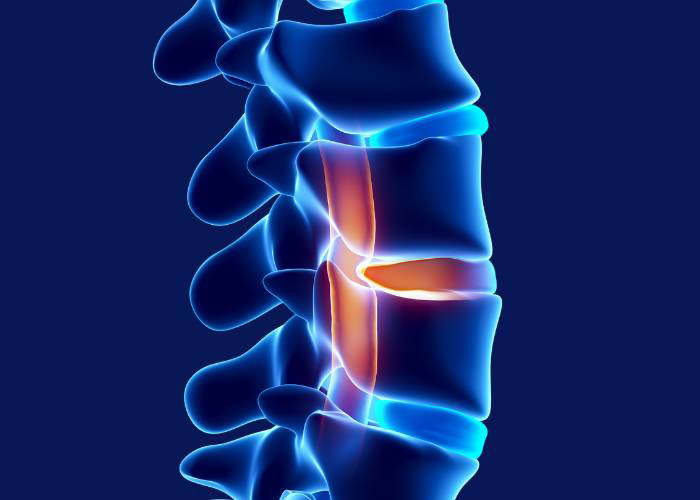What is a spinal cord injury?
The spinal cord is part of the central nervous system and a long, tube-like band of tissue. It connects the brain to the lower back and is responsible for carrying electrical signals from the brain to the body (and back again). A spinal cord injury occurs when there is damage to any part of the spinal cord or the nerves at the end of the spinal canal. Spinal cord injuries can differ in severity and can cause permanent changes to strength, sensation, and bodily function. Dr. Brenton Pennicooke, MD, a spinal cord injury specialist, treats patients in Saint Louis, Creve Coeur, and surrounding cities in St. Louis County, Missouri who have sustained a spinal cord injury.

What can cause a spinal cord injury?
The most common causes of spinal cord injuries involve auto and motorcycle accidents. Motor vehicle accidents account for nearly half of all spinal cord injuries each year. Other causes of spinal cord injuries include:
- Sports and recreational injuries
- Severe falls
- Acts of violence
- Gunshot wounds
- Surgical complications
- Diseases such as cancer, arthritis, or inflammation of the spinal cord
Who is at risk for a spinal cord injury?
Most spinal cord injuries are seen in men (78%). Individuals between the ages of 16 and 43 account for more than half of spinal cord injuries each year. Other risk factors include:
- Participating in risky behavior
- Those with certain diseases
- Alcohol use
- Those over the age of 65
Are there different types of spinal cord injury?
The types of spinal injuries are classified in 2 categories: Incomplete and complete. Over 60% of spinal injuries are incomplete and are further classified for where the injury occurred:
- Anterior Cord Syndrome: Occurs at the front of the spinal cord and involves motor damage and sensory pathway damage.
- Central Cord Syndrome: Occurs at the cord’s center and involves nerve damage.
- Brown-Sequard Syndrome: Occurs when one side of the spinal cord has been injured. Can involve weakness, paralysis and/or loss of sensation on one side of the body.
Complete Cord Injuries:
Nearly 40% of all spinal cord injuries are considered complete injuries. A complete cord injury occurs when the person loses all sensory and motor function below the level of spinal injury.
Spinal cord injuries are also classified by the level of the spine in which they occurred: Cervical, thoracic, lumbar, sacrum and coccyx.
Finally, spinal cord injuries are separated by grade:
- Grade A: Complete Impairment – no motor or sensory function below the level of injury
- Grade B: Incomplete injury with complete motor function loss but sensory incomplete
- Grade C: Incomplete Injury – some movement occurs, but less than half the muscle groups are able to lift with a full range of motion
- Grade D: Incomplete injury – more than half the muscle groups can lift with a full range of motion.
- Grade E: Normal function
What is a spinal concussion?
A spinal concussion occurs after an injury, when there is a transient (comes and goes) disturbance of spinal cord function. This type of injury is often seen in football players after a direct hit to the spine. Spinal concussions may resolve on their own in a day or two.
What are the symptoms of a spinal cord injury?
The symptoms of a spinal cord injury vary, depending on where the injury occurred on the spinal cord and the severity of the injury. In general, spinal cord injuries can cause:
- Loss of movement
- Loss of altered sensation (cannot feel hot or cold)
- Loss of bladder or bowl control
- Spasms or exaggerated reflexes
- Changes in sexual function
- Pain or an intense stinging sensation
- Difficulty breathing or coughing
How is a spinal cord injury diagnosed?
In trauma situations, if a spinal injury is suspected, it is important that the patient be carefully immobilized to prevent further injury. Once the patient is in Dr. Pennicooke’s care, he will assess neurological function by testing the strength of sensation in the arms and legs. It is important to keep the patient on a spine board and with a cervical collar until imaging is complete. Imaging may involve a CT Scan, MRI or an added x-ray. Dr. Pennicooke will carefully evaluate the information available to him from these scans to understand the severity of the injury and decide on a treatment plan.
How is a spinal cord injury treated?
Spinal cord injuries should always be treated with extreme care, beginning with immobilization before the patient is transported to the hospital.
Non-Surgical:
Patients with spinal cord injuries are usually taken to an ICU unit in a hospital. If the spinal cord injury is in the cervical spine (neck), non-surgical methods in a hospital setting may be utilized such as traction, blood pressure monitoring, and ensuring adequate ventilation.
Surgical:
If the spinal cord injury has caused other issues, Dr. Pennicooke may elect to take the patient to surgery. Surgical treatments may be necessary for:
- Herniated disc, pressing on the spinal cord
- Blood clot(s) caused by the injury
- Spinal lesion that may need to be removed
- Surgery to stabilize the spine and prevent further injury.
Unfortunately, the damage done by a spinal cord injury cannot always be reversed. Postoperatively, when a patient has stabilized, treatment focuses on supportive care and rehabilitation. Advances are being made in treating spinal cord injuries with some promising outcomes on the horizon.
Spinal Cord Injury Specialist

Spinal cord injuries are often the result of a severe trauma. It is important to treat spinal cord injuries quickly and carefully. Spinal cord injury specialist, Doctor Brenton Pennicooke, provides diagnosis as well as surgical and nonsurgical treatment options for patients in Saint Louis, Creve Coeur, and surrounding cities in St. Louis County, Missouri. who have experienced a spinal cord injury and are seeking the best treatment possible. Contact Dr. Pennicooke’s team today!